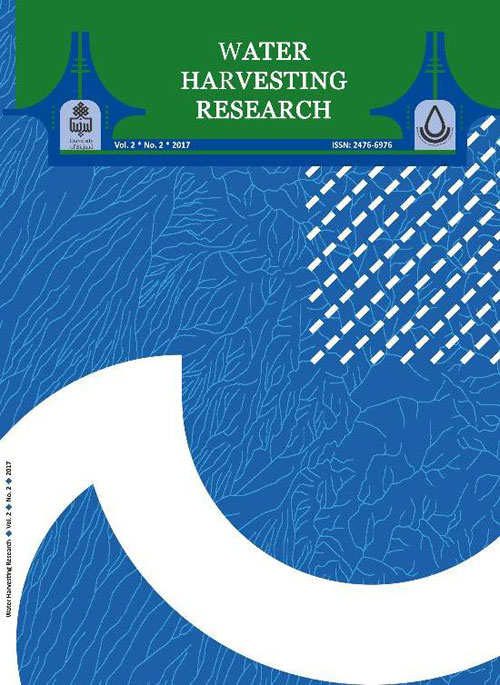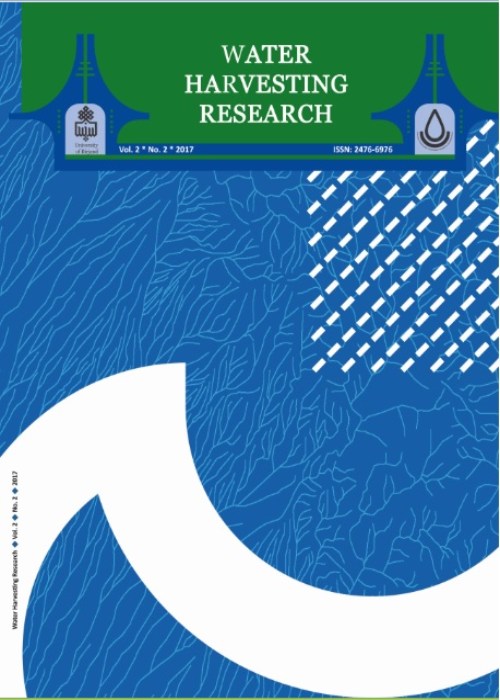فهرست مطالب

Journal of Water Harvesting Research
Volume:2 Issue: 1, Winter and Spring 2017
- تاریخ انتشار: 1395/12/11
- تعداد عناوین: 6
-
Pages 1-12Socio-economic assessment of rainwater harvesting systems considered as one of the efficient approaches in water resource management under deficit conditions, leads to a better management practice in the implementation of such systems. This work was aimed at analyzing the socio-economic limitations and potentials of rooftop catchment systems in Golestan province. The methodology was based on field surveying and questionnaire filling at 12 selected sites in Golestan province. Then, each site was hydrologically simulated according to different rainfall conditions, spill over magnitude, number of beneficiaries and volume of demand and reservoirs’ volumes were optimized. To evaluate the economic performance of the rooftop catchment system, Net Present Value (NPV) of a typical site was computed. Results showed that the system would not be economically justified even with a discount rate of 20% during 30 years of simulation. The total cost of implementation of a medium system and its maintenance was estimated to be 70 million Rls., while it only benefits 27000 Rls., annually. This could be a result of low price of water, a fact also confirmed by questionnaires results. Based on the social analysis of rooftop catchment systems, it was revealed that there was a high degree of satisfaction with these systems by residents and users, but it was not welcomed by the new generation of residents in the study area. This issue was mainly arisen from the entry and development of urban and rural water networks which were more convenient to use as compared with traditional systems. There were some other reasons in this background such as low level of knowledge and education about rooftop catchment systems, especially for new generations, as well as the initial cost of executing such systems.Keywords: Golestan province, Rainwater harvesting, socio-economic assessment, rooftop catchment system, Net Present Value
-
Pages 13-23Global warming due to greenhouse effect is expected to cause major changes in climate of some regions. The change of climate is likely to have a profound effect on hydrological cycle. Evapotranspiration (ET, as the major component of hydrological cycle, will affect crop water requirement and future planning and management of water resources. This study was conducted to investigate climate change impacts on spatiotemporal pattern of reference evapotranspiration (ETo) in Iran. To this purpose, using Hargreaves and Samani -formula and monthly meteorological data at 20 meteorological stations, ETo was calculated for the historical period. ETo was calculated for two future periods (2015-2045 and 2070-20799) from the outputs of 15 AOGCM models under three emission scenarios (A2, A1B, and B2). The spatial distribution of ETo was interpreted by Inverse Distance Weighted Interpolation method. Results showed that Scenarios A2 and A1B predict the same increase in annual mean ETo in both the future periods (5% and 15% for the first and the second future period, respectively), however in scenario B1, the amount of increase in ETo in the first and the second future periods were determined as 3% and 9.4 %, respectively. Spatial variation of annual ETo showed that the increase in ETo in future periods will be decreased by moving from the Persian Gulf regions toward the Northern regions.Keywords: AOGCM models, change, Emission scenarios, Reference evapotranspiration
-
Pages 24-36Lateral intake is a structure constructed next to a main channel to divert part of the flow within the channel. The separated area of the flow in the entrance of intake channel has no effect on flow discharge while reduces the effective cross-sectional area of the intake, as well as the bed load, which enters the intake due to low velocity flow deposits in this area. Thus, knowing the dimensions of the separated area at the intake channel entrance is particularly important. In this study, flow separation zone was calculated at the intake entrance of 90 degree in three depths of 3, 6, and 12 cm from the bottom of the channel for discharge ratios of 0.2 and 0.4, 0.6 and 0.8 in five turbulence models using three-dimensional Flow-3D model. In order to determine the accuracy of the model in predicting the dimensions of the separated areas, the obtained results were compared with the results of the physical model. Streamlines were drawn and dimensions of the separated areas were determined. In comparing results between the laboratory observations and the predicted ones by numerical model, Reynolds Normal Group model (RNG) had better predictions, with a correlation coefficient of 0.97, root mean square error of 3.16, and a mean absolute error of 2.3 cm, than other turbulence models.Keywords: Intake 90°, Flow pattern, Turbulence models, Flow-3D numerical model, Laboratory observations
-
Pages 37-42Iranians have a very long history of water harvesting to address water scarcity and the consequences of frequent droughts. Among these strategies, Bandsar is a wide spread indigenous practice, which has been utilized in the central and the southern part of Khorasan province (the northeast Iran). Bandsar in Persian means a series of consecutive bands, berms, levees, or dikes. A Bandsar consists of a series of levees constructed along contour lines and adjacent to an ephemeral stream in a way that occasional floodwater flows can be diverted from the stream into the field(s) of the Bandsar system, to temporarily store the water on the upstream side of the levees. Water gradually penetrates into the soil profile and the accumulated moisture can be used for an appropriate cultivation. Bandsar agriculture has been found to be very unique and sustainable with regards to several key factors such as owners' participation, land-use, and water resource management. In this regard, a field survey was conducted in the suburbs of Sabzevar (57o 4'E, 36o 12'N), which are widely covered with Bandsars, some of which are still being used in the present time. Bandsar's components, construction method, operation, and maintenance have been studied and summarized here according to the information gathered from field observations and face to face interviews with some of the most experienced Bandsar owners.Keywords: Bansdar, Floodwater, Runoff, Agriculture, Indigenous Knowledge
-
Pages 43-56
Flood is one of the most destructive natural hazards which impose vast costs in order to compensate its effects, especially in areas where there are manifestations of human development (such as cities). Urban development, particularly in the margins of rivers, has increased flood damages in recent decades. The aim of this study was to develop flood hazard maps of Birjand plain based on analyses of multi-criteria decision-making and geographic information system (GIS). This model was developed using six criteria including precipitation depth, basin slope, permeability, land use, proximity to river, and sub-basin shape. In this method, paired comparison of options was conducted by surveying the experts' opinions in this field using a questionnaire, and geometrical averaging was employed to calculate the weights of the criteria. According to the map prepared by means of Fuzzy Analytic Hierarchy Process (FAHP), 1.17 percent of the catchment area of Birjand is imposed to very probable hazard of flood and about 10.77 percent of the basin area is of high flood hazard. Moreover, in accordance with the Analytical Hierarchy Process )AHP( model, 3.29 percent of the basin is in the high hazard zone and 12.23 percent is located within the zone of high hazard. Comparison of results indicated that FAHP mapping approach is more compatible with the recorded data of recent floods.
Keywords: Fuzzy Analytic Hierarchy, Spatial Prioritizing, potential flooding area, Urban Basin -
Pages 57-67Recently, special attention has been paid to artificial groundwater recharge in water resource management in arid and semi-arid regions. Water resources distribution in these regions is extremely uneven, both in spatial and temporal forms and groundwater is the only water resource and is a major constraint on economic and social development. Artificial groundwater recharge is considered an appropriate strategy for overcoming the problem of water scarcity in these areas. Parameters considered in selecting groundwater artificial recharge locations are diverse and complex. In this study factors such as: land slopes, infiltration rate, depth of water table in aquifers, quality of alluvial sediments, land use, land owner density, geological consideration, and water quality and quantity are considered in determining the most suitable areas for groundwater recharge at Sarbisheh basin in the eastern part of Iran. Thematic layers for the above parameters were prepared, classified, weighted, and integrated in a GIS and RS environment by means of Analytic Hierarchy Process and fuzzy logic. Land-use maps were developed from satellite images and other digital maps of topography and geology alongside field investigations were also prepared. The results indicate that Analytic Hierarchy Process and fuzzy logic are reasonably suitable. However, the AHP is better than Fuzzy for practical purposes. Using different approaches for localizing provides the region with suitable context for developing and improving groundwater state. According to the results, employing Fuzzy methods, Boolean, and AHP are compatible with the proper location and this compatibility proves the goodness of the results.Keywords: Artificial recharge, Analytic Hierarchy Process (AHP), Fuzzy logic, GIS


